The Influence of a Fire at an Illegal Landfill in Southern Poland on the Formation of Toxic Compounds and Their Impact on the Natural Environment
Abstract
:1. Introduction
+ 0.001 × [Fen] + 0.01 × [An] + 0.001 × [Flu] + 0.001 × [Pir] + 0.1 × [BaA]
+ 0.01 × [Ch] + 0.1 × [BbF] + 0.1 × [BkF] + 1 × [BaP] +5 × [DBA] + 0.1 × [BghiP]
+ 0.1 × [IP]
+ 0.11 × [BkF] + 1 × [BaP] + 0.31 × [IP] + 0.29 × [DBA] + 0.19 × [BghiP]
+ 0.00110 × [IP] + 0.00203 × [DBA] + 0.00253 × [BbF] + 0.00487 × [BkF]
2. Materials and Methods
2.1. Study Area
2.2. Sampling
2.3. Sample Preparation and Characterization
2.3.1. Sample Preparation for Laboratory Analysis
2.3.2. Sample Preparation for GC-MS
2.3.3. Gas Chromatography-Mass Spectrometry (GC-MS)
3. Results and Discussion
3.1. PAH Concentrations in Soil and Combusted Solid Waste Samples from the Wild Landfill Fire
3.2. MPI Concentrations in Soil and Combusted Solid Waste Samples from the Wild Landfill Fire
3.3. Compound Contents in Leachate Samples of Burnt Solid Waste from the Wild Landfill Fire
4. Conclusions
Author Contributions
Funding
Institutional Review Board Statement
Informed Consent Statement
Conflicts of Interest
Nomenclature
| A—anthracene | Ace—acenaphthene |
| Acy—acenaphthylene | BaA—benzo(a)anthracene |
| BaF—benzo(a)fluoranthene | BaP—benzo(a)pyrene |
| Bb + kF—benzo(b + k)fluoranthene | BcF—benzo(c)fluoranthene |
| BcPhe—benzo(c)phenanthrene | BeP—benzo(e)pyrene |
| BghiFl—benzo(ghi)fluoranthene | BghiP—benzo(ghi)perylene |
| Ch—chrysene | DB—dibenzo(a + h)anthracene |
| DMR—Dimethylnaphthalene Ratio | Fl—fluoranthene |
| F—fluorene | GC-MS—Gas chromatography-mass spectrometry |
| IP—indeno[1,2,3-cd]pyrene | ICP-OES—Inductively Coupled Plasma Optical Emission Spectrometry |
| MNR—Methylnaphthalene Ratio | MOE—Ministry of Environment |
| MPI—Methylphenanthrene Index | MSW—Municipal solid waste |
| N—naphthalene | P—phenanthrene |
| PAHs—Polycyclic aromatic hydrocarbons | Pe—perylene |
| Py—pyrene | TEF—Toxicity Equivalence Factor |
| TEQ—Toxic Equivalent | TNR—Trimethylnaphthalene Ratio |
Appendix A
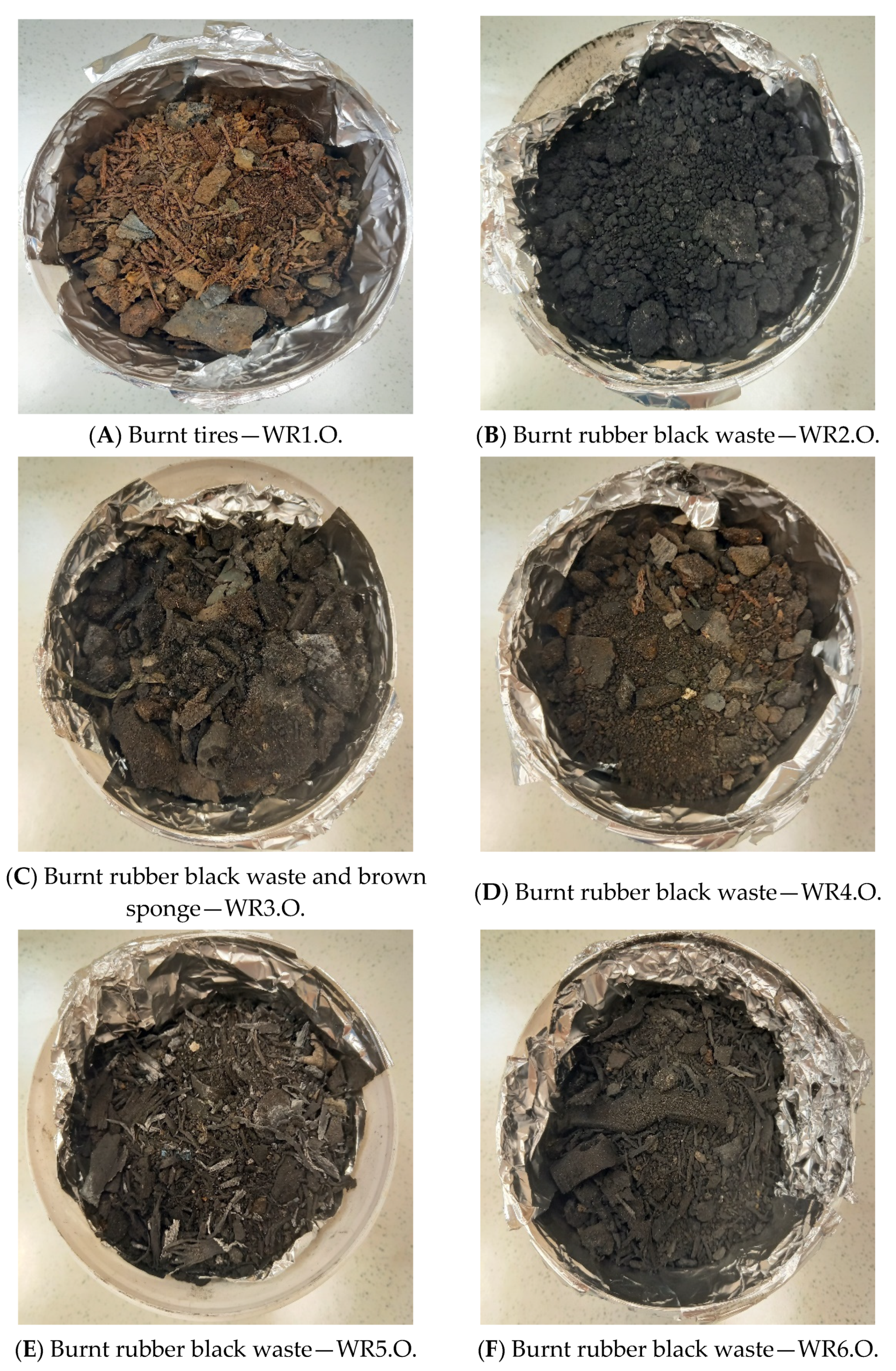
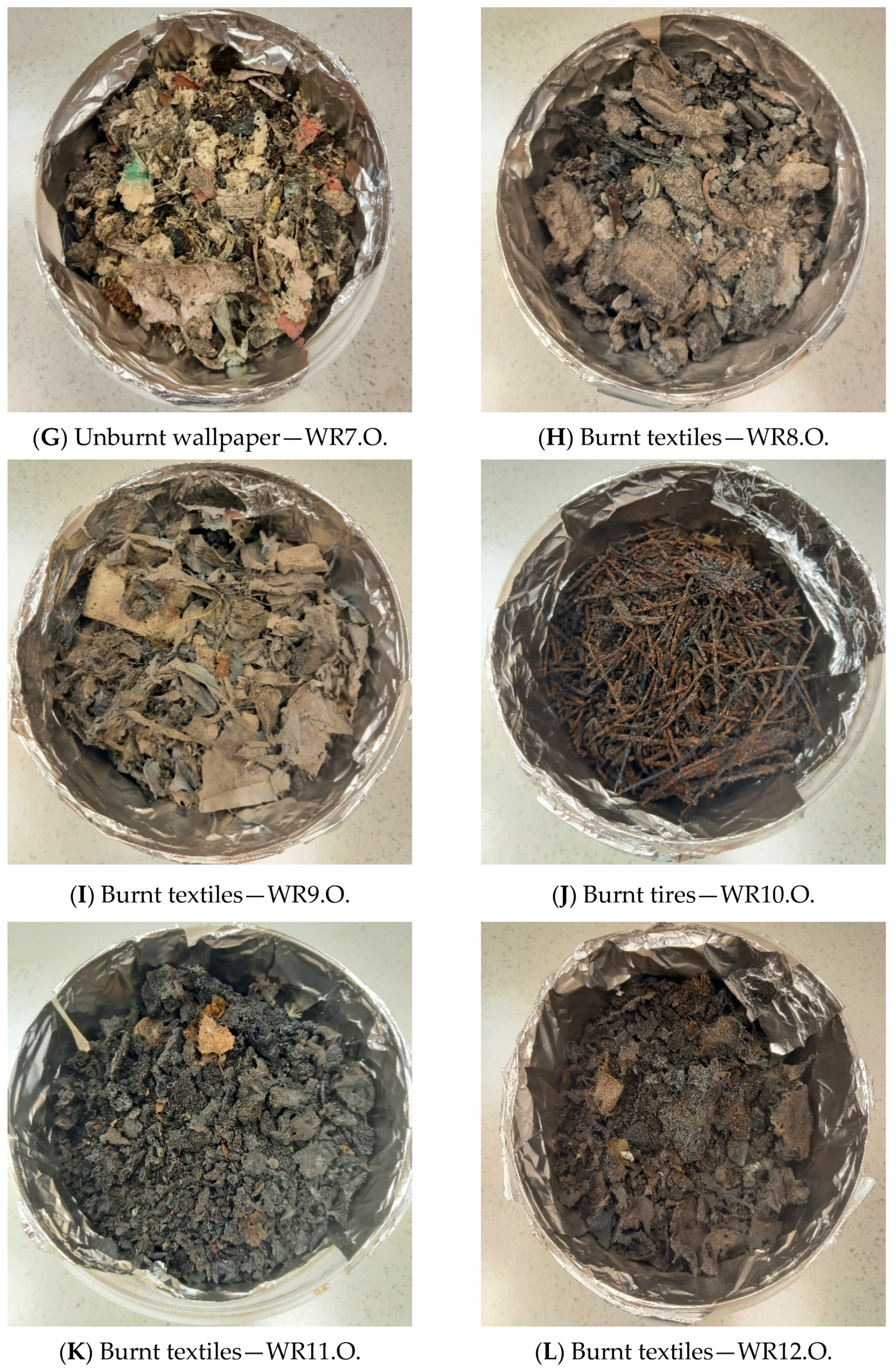
| Unit | SO4 [mg/L] | Cl [mg/L] | As [µg/L] | B [mg/l] | Cd [µg/L] | Cu [µg/L] | Pb [µg/L] | Zn [mg/L] | |
|---|---|---|---|---|---|---|---|---|---|
| No. | |||||||||
| WR1.O | 239.0 | 13.0 | 64.0 | 0.6 | 28.0 | 12.0 | 12.0 | 12.0 | |
| WR2.O | 534.0 | 38.0 | 82.0 | 1.0 | 0.1 | 4.9 | 13.0 | 1.9 | |
| WR3.O | 397.0 | 8.1 | 85.0 | 1.1 | 0.4 | 70.0 | 15.0 | 1.6 | |
| WR4.O | 255.0 | 76.0 | 59.0 | 3.1 | 1.5 | 50.0 | 9.6 | 2.9 | |
| WR5.O | 1670.0 | 83.0 | 9.0 | 4.6 | 18.0 | 760.0 | 41.0 | 100.0 | |
| WR6.O | 121.0 | 0.8 | 7.0 | 0.1 | 27.0 | 83.0 | 30.0 | 13.0 | |
| WR7.O | 20.8 | 30.0 | 7.0 | 0.1 | 0.2 | 150.0 | 12.0 | 0.85 | |
| WR8.O | 1240.0 | 320.0 | 14.0 | 0.4 | 35.0 | 300.0 | 13.0 | 56.0 | |
| WR9.O | 43.5 | 2.7 | 8.0 | 0.1 | 4.6 | 37.0 | 110.0 | 2.9 | |
| WR10.O | 220.0 | 16.0 | 6.0 | 0.2 | .5 | 68.0 | 16.0 | 30.0 | |
| WR11.O | 58.2 | 15.0 | 10.0 | 0.1 | 0.1 | 20.0 | 6.7 | 0.22 | |
| WR12.O | 17.9 | 20.0 | 35.0 | 0.1 | 0.9 | 59.0 | 33.0 | 0.25 | |
References
- Koda, E.; Pachuta, K.; Osinski, P. Potential of plant applications in the initial stage of the landfill reclamation process. Polish J. Environ. Stud. 2013, 22, 1731–1739. [Google Scholar]
- Vaverkova, M.D.; Elbl, J.; Koda, E.; Adamcova, D.; Bilgin, A.; Lukas, V.; Podlasek, A.; Kintl, A.; Wdowska, M.; Brtnicky, M.; et al. Chemical composition and hazardous effects of leachate from the active municipal solid waste landfill surrounded by farmlands. Sustainability 2020, 12, 4531. [Google Scholar] [CrossRef]
- Stańczyk-Mazanek, E.; Stępniak, L.; Kępa, U. Analysis of Migration of Polycyclic Aromatic Hydrocarbonsfrom Sewage Sludge Used for Fertilization to Soils, Surface Waters, and Plants. Water 2019, 11, 1270. [Google Scholar] [CrossRef] [Green Version]
- Øygard, J.; Mage, A.; Gjengedal, E.; Svane, T. Effect of an uncontrolled fire and the subsequent fire fight on the chemical composition of landfill leachate. Waste Manag. 2005, 25, 712–718. [Google Scholar] [CrossRef]
- Vaverkova, M.D.; Maxianova, A.; Winkler, J.; Adamcova, D.; Podlasek, A. Environmental consequences and the role of illegal waste dumps and their impact on land degradation. Land Use Policy 2019, 89, 104234. [Google Scholar] [CrossRef]
- Esa, M.R.; Halog, A.; Rigamonti, L. Strategies for minimizing construction and demolition wastes in Malaysia. Resour. Conserv. Recycl. 2017, 120, 219–229. [Google Scholar] [CrossRef]
- Lu, W. Big data analytics to identify illegal construction waste dumping: A Hong Kong study. Resour. Conserv. Recycl. 2018, 141, 264–272. [Google Scholar] [CrossRef]
- Kremser, K.; Thallner, S.; Strbik, D.; Spiess, S.; Kucera, J.; Vaculovic, T.; Vsiansky, D.; Haberbauer, M.; Mandl, M.; Guebitz, G. Leachability of metals from waste incineration residues by iron and sulfur-oxidizing bacteria. J. Environ. Manag. 2021, 280, 111734. [Google Scholar] [CrossRef]
- Ichinose, D.; Yamamoto, M. On the relationship between the provision of waste management service and illegal dumping. Resour. Energy Econ. 2010, 33, 79–93. [Google Scholar] [CrossRef]
- Bihałowicz, J.; Rogula-Kozlowska, W.; Krasuski, A. Contribution of landfill fires to air pollution—An assessment methodology. Waste Manag. 2021, 125, 182–191. [Google Scholar] [CrossRef]
- Nagpure, A. Assessment of quantity and composition of illegal dumped municipal solid waste (MSW) in Delhi. Resour. Conserv. Recycl. 2018, 141, 54–60. [Google Scholar] [CrossRef]
- Sarabatin, M.A. RM2b Urus Sisa Pepejal. Berita Harian, 5 February 2016. [Google Scholar]
- Jeff, P. Landfill Fire Case Study and Discussion. Missouri Waste Control Coalition Environmental Conference 2018, USA. Available online: http://www.mowastecoalition.org/resources/Documents/2018%20conference/2018%20%20MWCC%20-%20Landfill%20Fire%20Presentation.pdf (accessed on 15 September 2022).
- Aderemi, A.; Otitoloju, A. An assessment of landfill fires and their potential health effects—A case study of a municipal solid waste landfill in Lagos, Nigeria. Int. J. Environ. Prot. 2012, 2, 22–26. [Google Scholar]
- Tchobanoglous, G.; Theisen, H.; Vigil, S.A. Integrated Solid Waste Management: Engineering Principles and Management Issues; McGraw-Hill: New York, NY, USA, 1993. [Google Scholar]
- Stearns, R.P.; Peyotan, G.S. Utilization of landfills as building sites. Waste Manag. Res. 1984, 2, 75–83. [Google Scholar] [CrossRef]
- United States Fire Administration. Landfill Fires—Their Magnitude, Characteristics and Mitigation. US Fire Administration 2002, Emmetsburg, USA. Available online: www.usfa.fema.gov/downloads/pdf/publications/fa-225.pdf (accessed on 15 September 2022).
- Downard, J.; Singh, A.; Bullard, R.; Jayarathne, T.; Rathnayake, C.; Simmons, D.; Wels, B.; Spak, S.; Peters, T.; Beardsley, D. Uncontrolled combustion of shredded tires in a landfill e Part 1: Characterization of gaseous and particulate emissions. Atmos. Environ. 2014, 10, 195–204. [Google Scholar] [CrossRef]
- New Zealand Ministry of Environment. Landfill Guidelines: Hazards of Burning on Landfills; Technology Representatives; New Zealand Ministry of Environment: Thorndon, New Zealand, 1997. [Google Scholar]
- Koda, E.; Miszkowska, A.; Sieczka, A.; Osiński, P. Heavy metal contamination within a restored landfill site. Environ. Geotech. 2018, 7, 512–521. [Google Scholar] [CrossRef]
- Abiriga, D.; Vestgarden, L.; Klempe, H. Groundwater contamination from a municipal landfill: Effect of age, landfill closure, and season on groundwater chemistry. Sci. Total Environ. 2020, 737, 140307. [Google Scholar] [CrossRef]
- Sladek, T.A. Workshop on Disposal Techniques with Energy Recovery for Scrapped Vehicle Tires; City and County of Denver; The Energy Task Force of the Urban Consortium for Technology Initiatives; U.S. Department of Energy: Denver, CO, USA, 1987. [Google Scholar]
- DeMarini, D.M.; Lemieux, P.M.; Ryan, J.V.; Brooks, L.R.; Williams, R.W. Mutagenicity and chemical analysis of emissions from the open burning of scrap rubber tires. Environ. Sci. Technol. 1994, 28, 136. [Google Scholar] [CrossRef]
- Wang, C.; Li, D.; Zhai, T.; Wang, H.; Sun, Q.; Li, H. Direct conversion of waste tires into three-dimensional graphene. Energy Storage Mater. 2019, 23, 499–507. [Google Scholar] [CrossRef]
- Seidelt, S.; Muller-Hagedorn, A.; Bockhorn, H. Description of tire pyrolysis by thermal degradation behaviour of main components. J. Anal. Appl. Pyrolysis 2006, 75, 11–18. [Google Scholar] [CrossRef]
- Silva, A.; Prata, J.; Duarte, A.; Soares, A.; Barcelo, D.; Rocha-Santos, T. Microplastics in landfill leachates: The need for reconnaissance studies and remediation technologies. Case Stud. Chem. Environ. Eng. 2021, 3, 100072. [Google Scholar] [CrossRef]
- Mahon, A.M.; O’Connell, B.; Healy, M.G.; O’Connor, I.; Officer, R.; Nash, R. Microplastics in sewage sludge: Effects of treatment, Environ. Sci. Technol. 2016, 51, 810–818. [Google Scholar] [CrossRef] [Green Version]
- Sundt, P.; Schulze, P.E.; Syversen, F. Sources of Microplastic-Pollution to the Marine Environment Project. Report Norweg Environ Agency 2020, Report nr: M-321/2015. Available online: https://www.miljodirektoratet.no/globalassets/publikasjoner/M321/M321.pdf (accessed on 15 September 2022).
- Bi, C.; Chen, Y.; Zhao, Z.; Li, Q.; Zhou, Q.; Ye, Z.; Ge, X. Characteristics, sources and health risks of toxic species (PCDD/Fs, PAHs and heavy metals) in PM2.5 during fall and winter in an industrial area. Chemosphere 2020, 238M, 124620. [Google Scholar] [CrossRef]
- Loehr, R.C.; Erickson, D.C.; Kelmar, L.A. Characteristics of residues at hazardous waste land treatment units wat. Water Res. 1993, 27, 1127–1138. [Google Scholar] [CrossRef]
- Wild, S.R.; Jones, K.C. Polynuchear aromatic hydrocarbon on the United Kingdom environment—A preliminary source inventory and budget. Env. Pollut. 1995, 88, 91–108. [Google Scholar] [CrossRef]
- Ruokojani, P.; Ruuskanen, J.; Ettala, M.; Rahkonen, P.; Jarhanen, J. Formation of polyaromatic hydrocarbons and phychlonated organic compounds in municipal waste landfill fires. Chemosphere 1995, 31, 3899–3908. [Google Scholar] [CrossRef]
- Raudonyte-Svirbutaviciene, E.; Stakeniene, R.; Joksas, K.; Valiulis, D.; Bycenkiene, S.; Zarkow, A. Distribution of polycyclic aromatic hydrocarbons and heavy metals in soil following a large tire fire incident: A case study. Chemosphere 2022, 286, 131556. [Google Scholar] [CrossRef]
- Escobar-Arnanz, J.; Mekni, S.; Blanco, G.; Eljarrat, E.; Barcelo, D.; Ramos, L. Characterization of organic aromatic compounds in soils affected by an uncontrolled tire landfill fire through the use of comprehensive two-dimensional gas chromatography–time-of-flight mass spectrometry. J. Chromatogr. A 2017, 1536, 163–175. [Google Scholar] [CrossRef]
- Rim-Rukeh, A. An assessment of the contribution of municipal solid waste dump sites fire to atmospheric pollution. Open J. Air Pollut. 2014, 3, 53–60. [Google Scholar] [CrossRef] [Green Version]
- Cocean, I.; Diaconu, M.; Cocean, A.; Postolachi, C.; Gurlui, S. Landfill Waste Fire Effects Over Town Areas Under Rainwaters. IOP Conf. Ser. Mater. Sci. Eng. 2020, 877, 012048. [Google Scholar] [CrossRef]
- Kim, K.H.; Jahan, S.A.; Kabir, E.; Brown, R.J.C. A review of airborne polycyclic aromatic hydrocarbons (PAHs) and their human health effects. Environ. Int. 2013, 60, 71–80. [Google Scholar] [CrossRef]
- White, P.A. The genotoxicity of priority polycyclic aromatic hydrocarbons in complex mixtures. Mutat. Res. 2002, 515, 85–98. [Google Scholar] [CrossRef]
- Nisbet, I.C.T.; LaGoy, P.K. Toxic equivalency factors (TEFs) for polycyclic aromatic hydrocarbons (PAHs). Regul. Toxicol. Pharmacol. 1992, 16, 290–300. [Google Scholar] [CrossRef]
- Rogula-Kozłowska, W.; Kozielska, B.; Klejnowski, K. Concentration, origin and health hazard from fi ne particle-bound PAH at three characteristic sites in Southern Poland. Bull. Environ. Contam. Toxicol. 2013, 91, 349–355. [Google Scholar] [CrossRef] [PubMed] [Green Version]
- Rybicki, M.; Marynowski, L.; Simoneit, B. Composition of organic compounds from low-temperature burning of lignite and their application as tracers in ambient air. Chemosphere 2020, 249, 126087. [Google Scholar] [CrossRef]
- Philp, R.P. Fossil Fuel Biomarkers. In Application and Spectra; Elsevier: Amsterdam, The Netherlands, 1985; p. 294. [Google Scholar]
- Liu, H.; Liang, Y.; Zhang, D.; Wang, C.; Liang, H.; Cai, H. Impact of MSW landfill on the environmental contamination of phthalate esters. Waste Manag. 2010, 30, 1569–1576. [Google Scholar] [CrossRef]
- Fabiańska, M.; Misz-Kennan, M.; Ciesielczuk, J.; Pierwoła, J.; Nitecka, N.; Brzozowski, J. Thermal history of coal wastes reflected in their organic geochemistry and petrography; the case study: The Katowice-Wełnowiec dump, Poland. Int. J. Coal Geol. 2017, 184, 11–26. [Google Scholar] [CrossRef]
- Fabiańska, M.; Ciesielczuk, J.; Misz-Kennan, M.; Kruszewski, L.; Kowalski, A. Preservation of coal-waste geochemical markers in vegetation and soil on self-heating coal-waste dumps in Silesia, Poland. Geochemistry 2016, 76, 211–226. [Google Scholar] [CrossRef]
- CalEPA. Tire Fire Report Office of Environmental Health Hazard Assessment; California Environmental Protection Agency: Sacramento, CA, USA, 2002. [Google Scholar]
- Lemieux, P.; Lutes, C.; Santoianni, D. Emissions of organic air toxics from open burning: A comprehensive review. Prog. Energy Combust. Sci. 2004, 30, 1–32. [Google Scholar] [CrossRef]
- Simoneit, B.R.T. Biomarker PAHs in the environment. In The Handbook of Environmental Chemistry, PAHs and Related Compounds; Neilson, A.H., Ed.; Springer-Verlag: Berlin/Heidelberg, Germany, 1998; Volume 3, pp. 176–221. [Google Scholar]
- Pereira, W.E.; Hostettler, F.D.; Luoma, S.N.; van Geen, A.; Fuller, C.C.; Anima, R.J. Sedimentary record of anthropogenic and biogenic polycyclic aromatic hydrocarbons in San Francisco Bay (California). Mar. Chem. 1999, 64, 99–113. [Google Scholar] [CrossRef]
- Carl, E.C.; John, B.S. 7—Bioremediation of Polycyclic Aromatic Hydrocarbons by Liqninolytic and non Ligninolytic Fungi; Cambridge University Press: London, UK, 2009; pp. 136–187. [Google Scholar]
- Charriau, A.; Bodineau, L.; Ouddane, B.; Fischer, J.-C. Polycyclic aromatic hydrocarbons and n-alkanes in sediments of the Upper Scheldt River Basin: Contamination levels and source apportionment. J. Environ. Monit. 2009, 11, 1086–1093. [Google Scholar] [CrossRef] [Green Version]
- Wang, X.J.; Chen, J.; Zhang, Z.H.; Piao, X.Y.; Hu, J.D.; Tao, S. Distribution and Sources of Polycyclic Aromatic Hydrocarbons in Soil Profiles of Tianjin Area, People’s Republic of China. Bull Env. Contam Toxicol 2004, 73, 739–748. [Google Scholar] [CrossRef]
- Yasuda, K.; Kaneko, M.; Yoshino, H. Basic research on the emission of polycyclic aromatic hydrocarbons caused by waste incineration. JAPCA 1989, 39, 1557–1561. [Google Scholar] [CrossRef]
- Mostert, M.R.M.; Ayoko, G.A.; Kokot, S. Application of chemometrics to analysisof soil pollutants. TRAC Trends Anal. Chem. 2010, 29, 430–445. [Google Scholar] [CrossRef] [Green Version]
- Chrysikou, L.; Gemenetzis, P.; Kouras, A.; Manoli, E.; Terzi, E.; Samara, C. Distribution of persistent organic pollutants, polycyclic aromatic hydrocarbons and trace elements in soil and vegetation following a large scale landfill fire in northern Greece. Environ. Int. 2008, 34, 210–225. [Google Scholar] [CrossRef]
- Wcisło, E. Soil Contamination with Polycyclic Aromatic Hydrocarbons (PAHs) in Poland—A Review. Pol. J. Environ. Stud. 1998, 7, 267–272. [Google Scholar]
- Maliszewska-Kordybach, B.; Smreczak, B.; Klimkowicz-Pawlas, A.; Terelak, H. Monitoring of the total content of polycyclic aromatic hydrocarbons (PAHs) in arable soils in Poland. Chemosphere 2008, 73, 1284–1291. [Google Scholar] [CrossRef]
- Musa Badowe, B.A.; Shukurov, N.; Leimer, S.; Kersten, M.; Steinberger, Y.; Wilcke, W. Polycyclic aromatic hydrocarbons (PAHs) in soils of an industrial area in semi-arid Uzbekistan: Spatial distribution, relationship with trace metals and risk assessment. Environ. Geochem. Health 2021, 43, 4847–4861. [Google Scholar]
- Gune, M.; Ma, W.; Sampath, S.; Li, W.; Li, Y.; Udayashankar, H.; Balakrishna, K.; Zhang, Z. Occurrence of polycyclic aromatic hydrocarbons (PAHs) in air and soil surrounding a coal-fired thermal power plant in the south-west coast of India. In Environmental Science and Pollution Research; Springer: Berlin/Heidelberg, Germany, 2019. [Google Scholar] [CrossRef]
- Zhang, D.; An, T.; Qiao, M.; Loganathan, B.; Zeng, X.; Sheng, G.; Fu, J. Source identification and health risk of polycyclic aromatic hydrocarbons associated with electronic dismantling in Guiyu town, South China. J. Hazard. Mater. 2011, 192, 1–7. [Google Scholar] [CrossRef]
- Jelonek, Z.; Fabiańska, M.; Jelonek, I. Quantitative Assessment of Organic and Inorganic Contaminants in Charcoal. Resources 2021, 10, 69. [Google Scholar] [CrossRef]
- Bourotte, C.; Forti, M.C.; Taniguchi, S.; Bícego, M.C.; Lotufo, P. A wintertime study of PAHs in fine and coarse aerosols in São Paulo city, Brazil. Atmos. Environ. 2005, 39, 3799–3811. [Google Scholar] [CrossRef]
- Parra, Y.J.; Oloyede, O.O.; Pereira, G.M.; De Almeida Lima, P.H.A.; Da Silva Caumo, S.E.; Morenikeji, O.A.; De Castro Vasconcellos, P. Polycyclic aromatic hydrocarbons in soils and sediments in Southwest Nigeria. Environ. Pollut. 2020, 259, 113732. [Google Scholar] [CrossRef] [PubMed]
- Li, C.; Zhang, X.; Gao, X.; Qi, S.; Wang, Y. The Potential Environmental Impact of PAHs on Soil and Water Resources in Air Deposited Coal Refuse Sites in Niangziguan Karst Catchment, Northern China. Int. J. Environ. Res. Public Health 2019, 16, 1368. [Google Scholar] [CrossRef] [PubMed] [Green Version]
- Musilli, A. Landfill elevated internal temperature detection and landfill fire index assessment for fire monitoring. Theses Diss. 2016, 2340. Available online: https://rdw.rowan.edu/etd/2340 (accessed on 15 September 2022).
- Radke, M.; Welte, D.H.; Willsch, H. Maturity parameters based on aromatic hydrocarbons: Influence of the organic matter type. Org. Geochem. 1986, 10, 51–63. [Google Scholar] [CrossRef]
- Radke, M. Organic geochemistry of aromatic hydrocarbons. Adv. Pet. Geochem. 1988, 2, 141–203. [Google Scholar]
- Fabiańska, M.; Smółka-Danielowska. Biomarker compounds in ash from coal combustion in domestic furnaces (Upper Silesia Coal Basin, Poland). Fuel 2012, 102, 333–344. [Google Scholar] [CrossRef]
- Fabiańska, M.; Kozielska, B.; Konieczyński, J.; Kowalski, A. Sources of organic pollution in particulate matter and soil of Silesian Agglomeration (Poland): Evidence from geochemical markers. Env. Geochem. Health 2016, 38, 821–842. [Google Scholar] [CrossRef]
- Hennerbert, P.; Lambert, S.; Fouillen, F.; Charrasse, B. Assessing the environmental impact of shredded tires as embankment fill material. Can. Geotech. J. 2014, 51, 469–478. [Google Scholar] [CrossRef]
- Backer, L. Assessing the acute gastrointestinal effects of ingesting naturally-occurring high levels of sulfate in drinking water. CRC Rev. Clin. Lab. Sci. 2000, 37, 389–400. [Google Scholar] [CrossRef]
- Dąbrowska, D.; Witkowski, A.; Sołtysiak, M. Application of pollution indices for the assessment of the negative impact of a municipal landfill on groundwater (Tychy, southern Poland). Geol. Q. 2018, 62, 496–508. [Google Scholar] [CrossRef] [Green Version]
- Regulation 2015. Regulation of the Minister of Economy of 16 July 2015 on the acceptance of waste to landfills. J. Laws 2015, 1277. [Google Scholar]
- Połap, D.; Winnicka, A.; Serwata, K.; Kęsik, K.; Woźniak, M. An Intelligent System for Monitoring Skin Diseases. Sensors 2018, 18, 2552. [Google Scholar] [CrossRef] [Green Version]
- Winnicka, A.; Kęsik, K.; Połap, D.; Woźniak, M.; Marszałek, Z. A Multi-Agent Gamification System for Managing Smart Homes. Sensors 2019, 19, 1249. [Google Scholar] [CrossRef] [Green Version]
- Samara, C. Chemical mass balance source apportionment of TSP in a lignite-burning area of Western Macedonia, Greece. Atmospheric Environ. 2005, 39, 6430–6443. [Google Scholar] [CrossRef]
- Nadal, M.; Schuhmacher, M.; Domingo, J.L. Levels of metals, PCBs, PCNs and PAHs in soils of a highly industrialized chemical/petrochemical area: Temporal trend. Chemosphere 2007, 66, 267–276. [Google Scholar] [CrossRef]
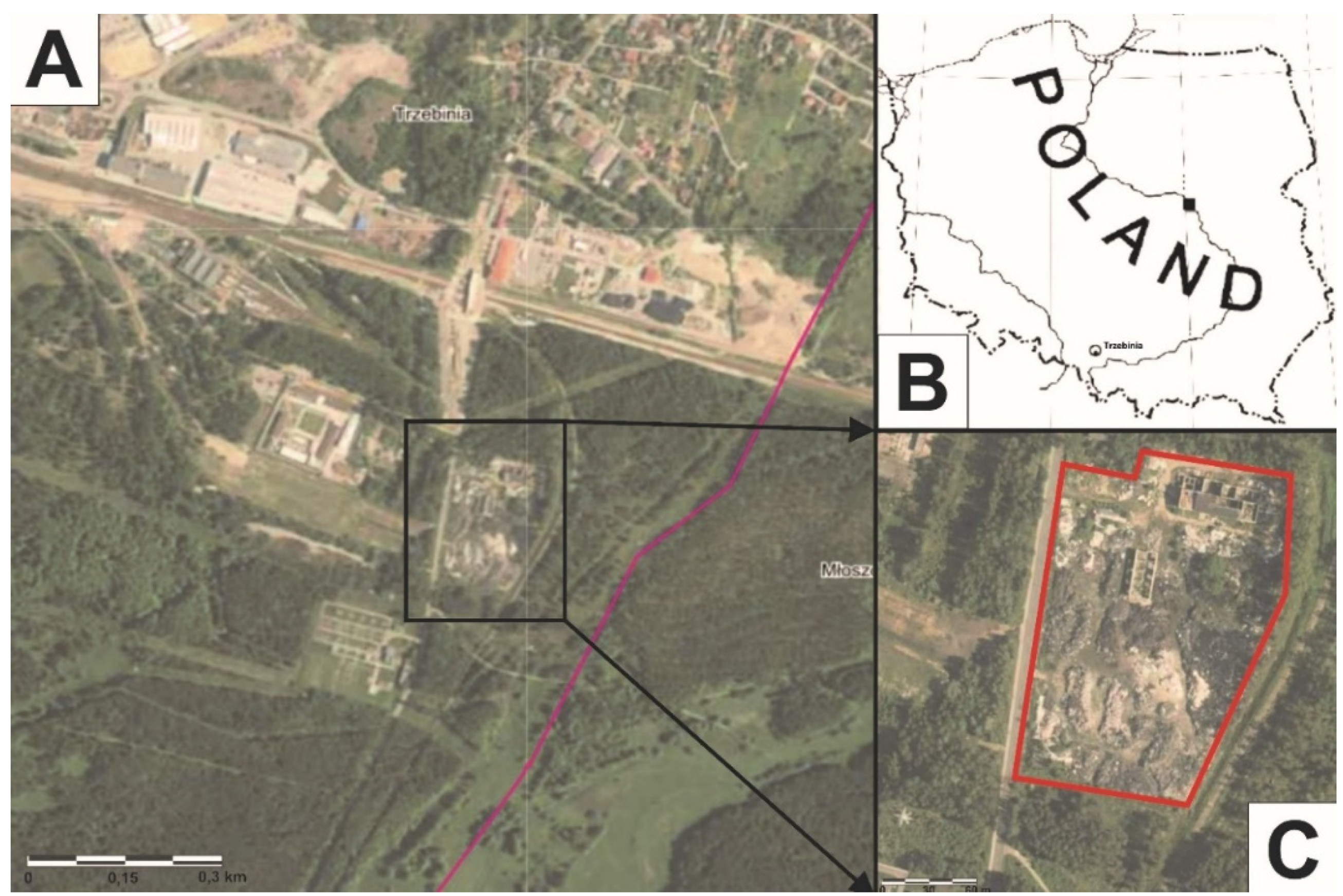
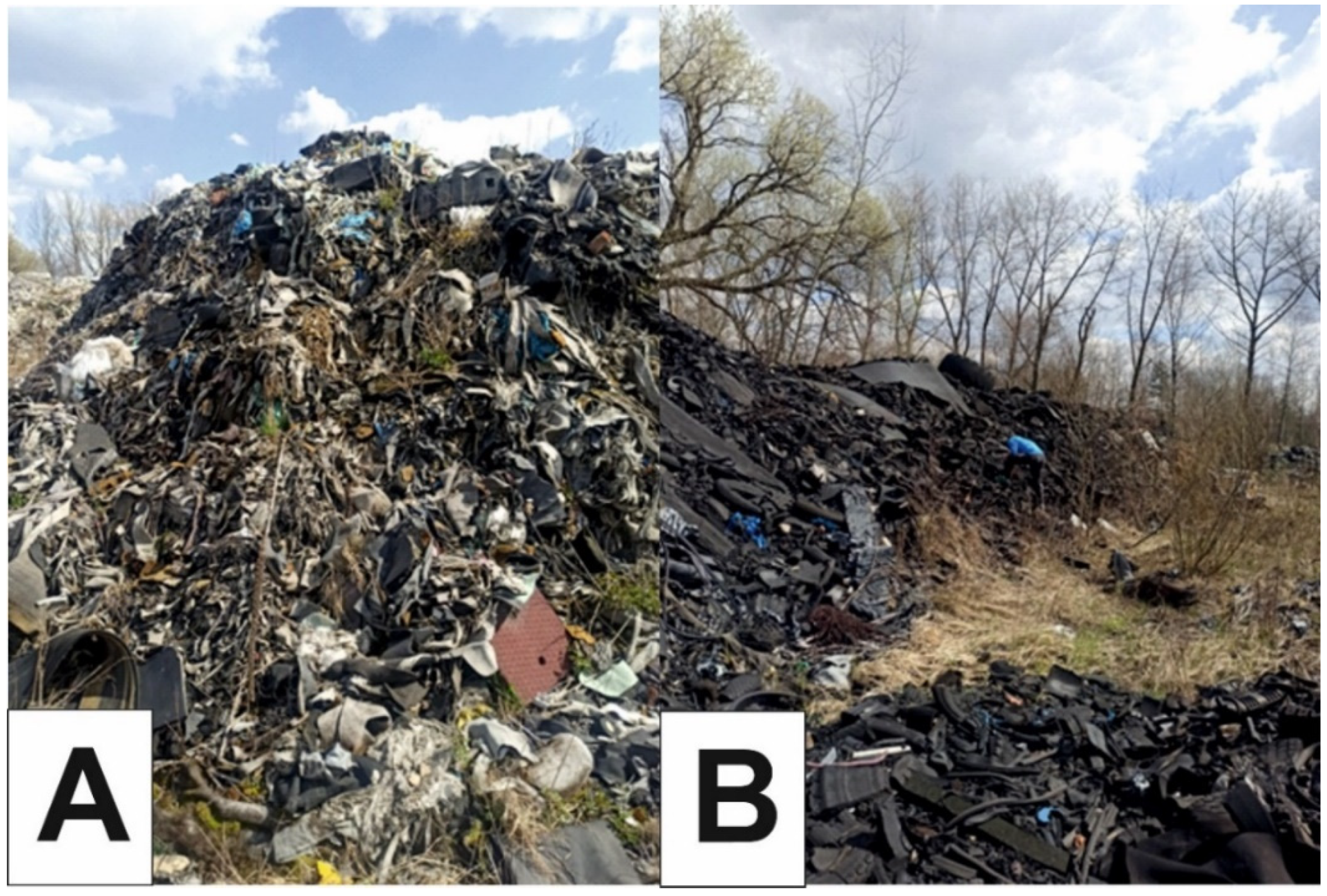
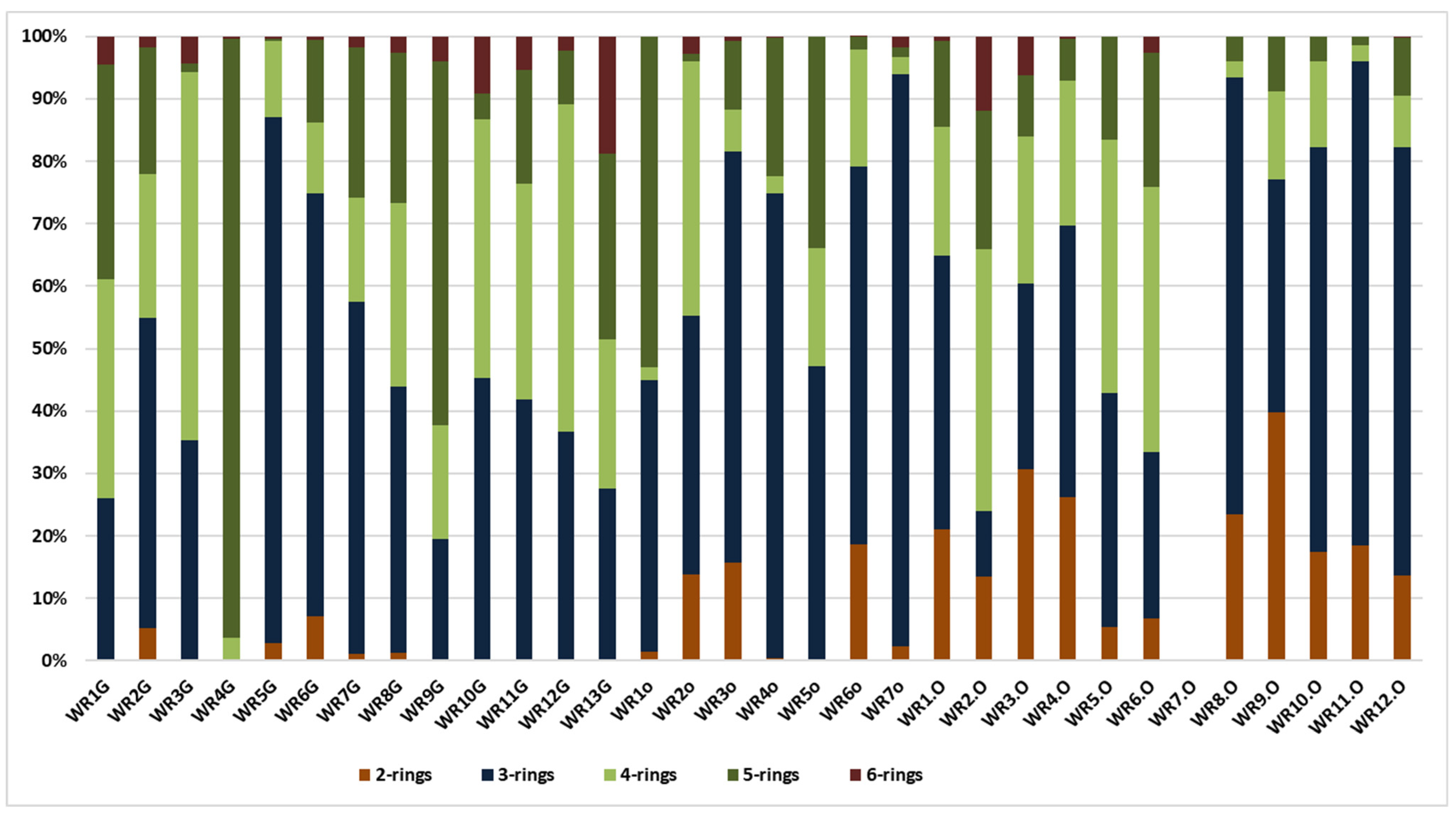
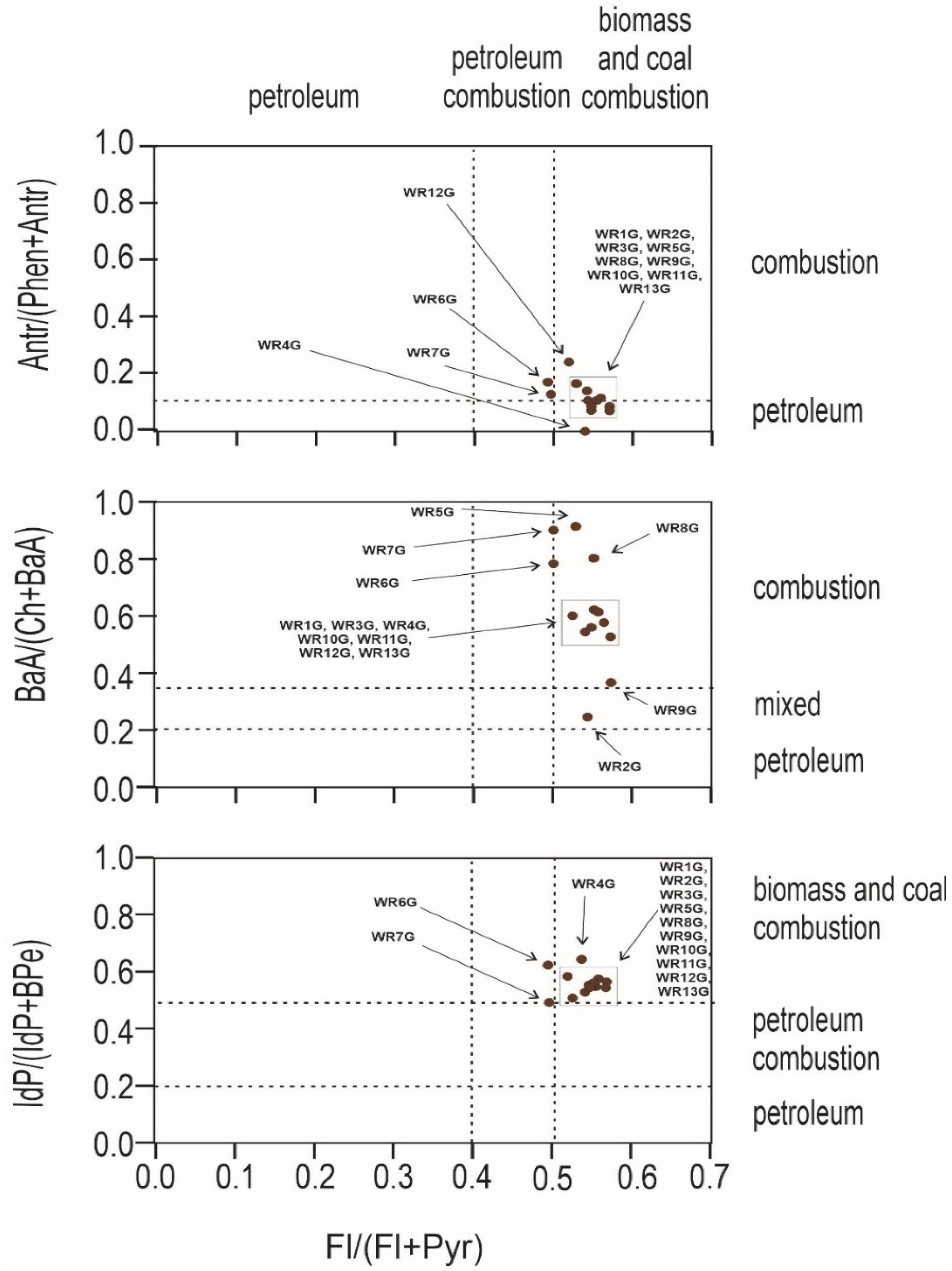
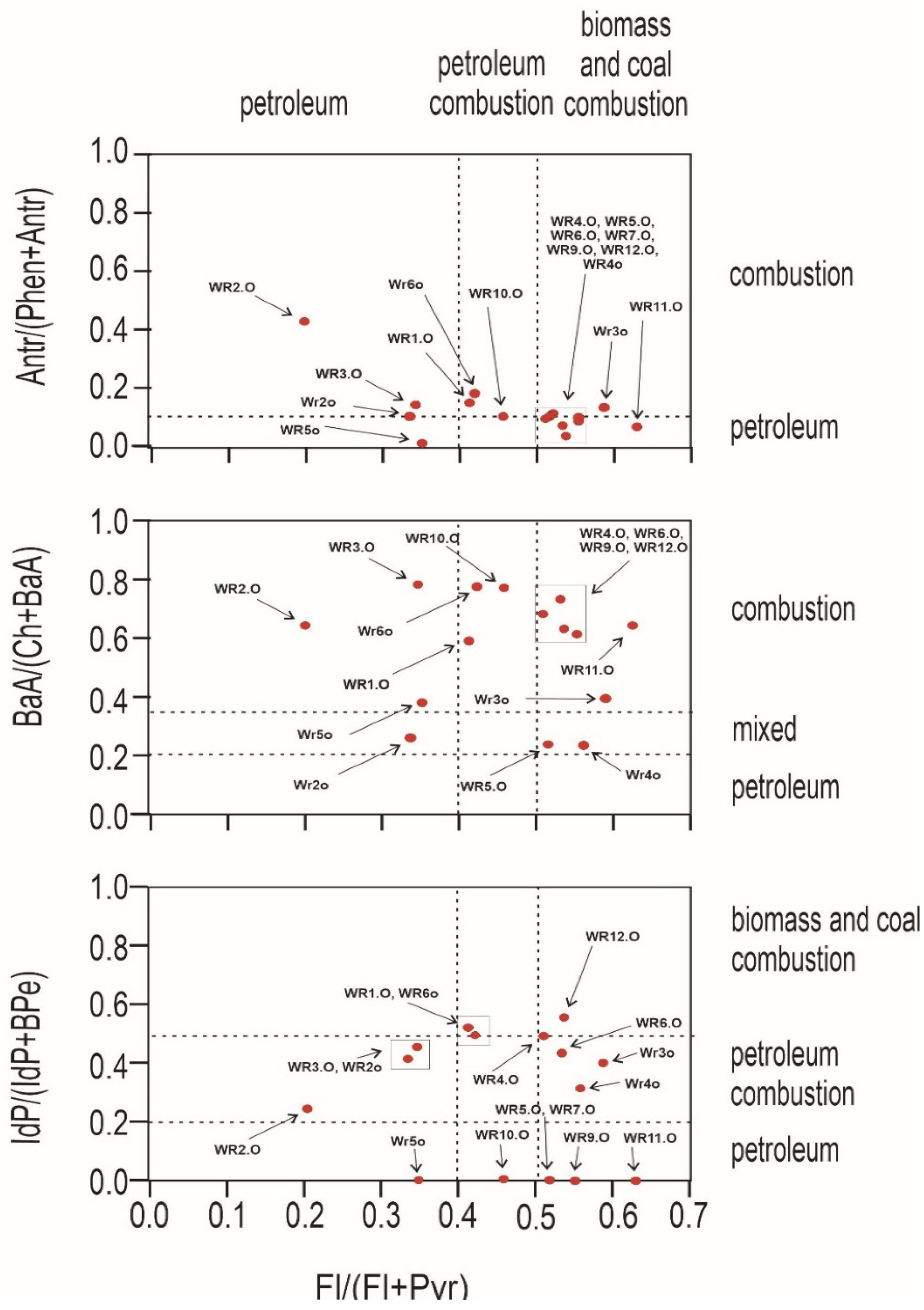
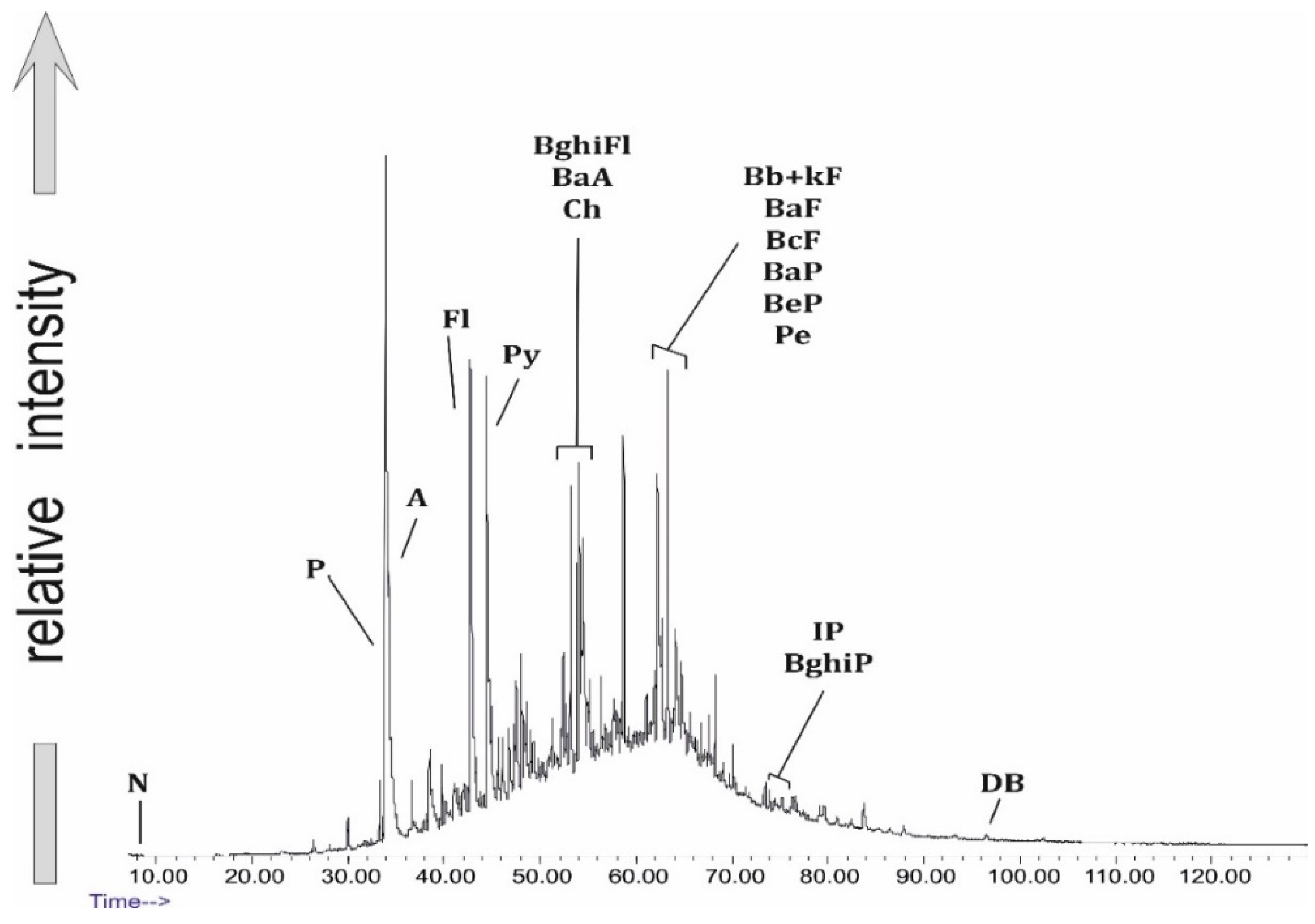
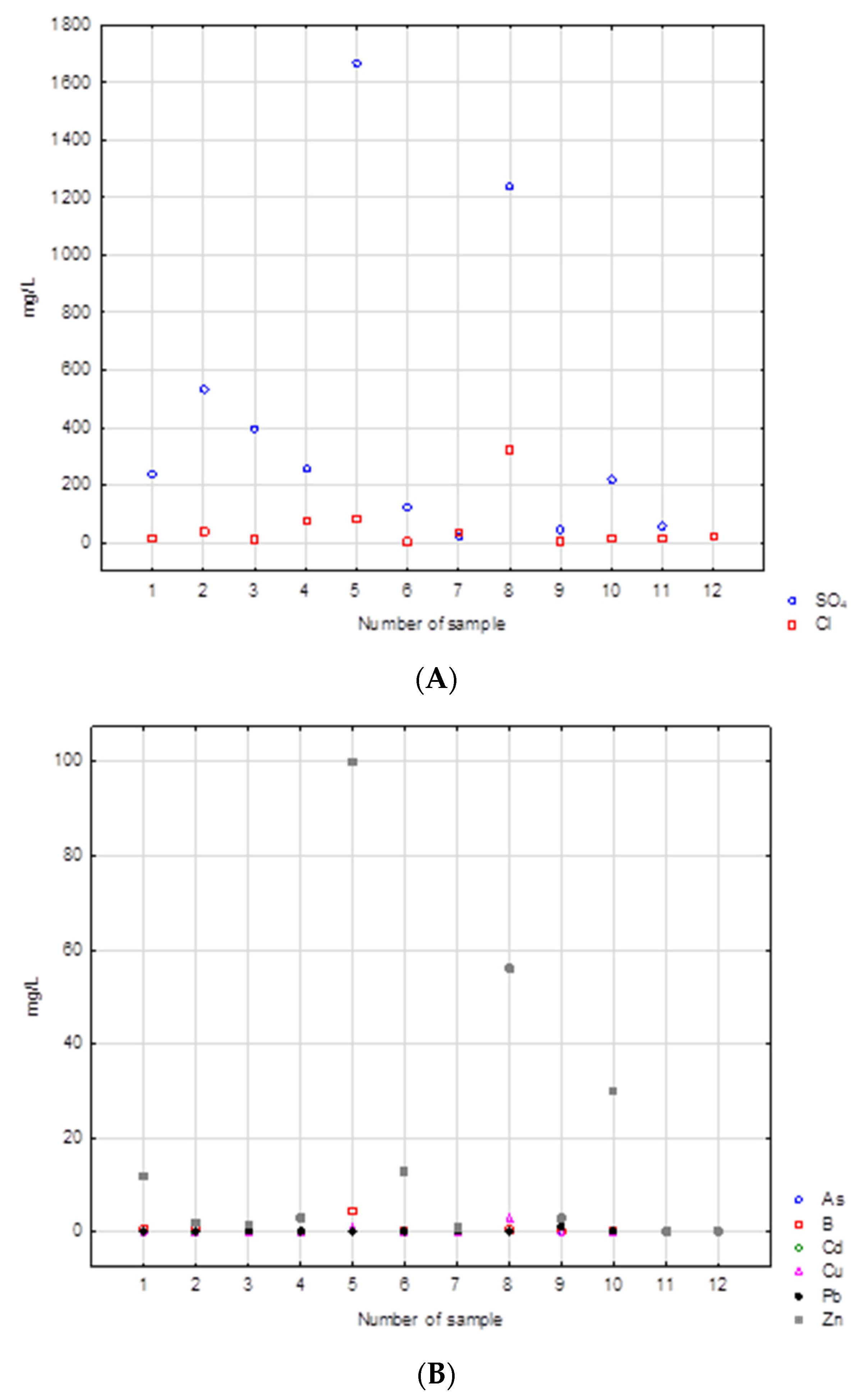
| Sample | Description of the Sample | Sample | Description of the Sample |
|---|---|---|---|
| WR1G | soil sample | WR12G | soil sample |
| WR2G | soil sample | WR6O | burnt waste sample |
| WR3G | soil sample | WR7O | burnt waste sample |
| WR1O | burnt waste sample | WR13G | soil sample |
| WR4G | soil sample | WR1.O | burnt tires |
| WR2O | burnt waste sample | WR2.O | burnt rubber black waste |
| WR5G | soil sample | WR3.O | burnt rubber black waste and brown sponge |
| WR6G | soil sample | WR4.O | burnt rubber black waste |
| WR7G | soil sample | WR5.O | burnt rubber black waste |
| WR8G | soil sample | WR6.O | burnt rubber black waste |
| WR3O | burnt waste sample | WR7.O | unburnt wallpaper |
| WR4O | burnt waste sample | WR8.O | burnt textiles |
| WR9G | soil sample | WR9.O | burnt textiles |
| WR10G | soil sample | WR10.O | burnt tires |
| WR11G | soil sample | WR11.O | burnt textiles |
| WR5O | burnt waste sample | WR12.O | burnt textiles |
| Sample | N | F | P | A | Ace | Acy | Fl | Py | BcPhe | BaA | Ch | BghiFl | Bb + kF | BaF |
| WR1G | - | 0.078 | 6.321 | 0.018 | 0.007 | 0.374 | 0.184 | 5.338 | 0.067 | 1.599 | 2.053 | 0.067 | 2.902 | 0.862 |
| WR2G | 5.045 | 0.076 | 33.445 | 0.025 | 4.247 | 9.319 | 0.427 | 12.036 | 0.267 | 3.628 | 5.658 | 0.267 | 6.053 | 1.360 |
| WR1O | 0.231 | 0.554 | 2.937 | 0.006 | 2.884 | 0.747 | 0.011 | 0.019 | 0.021 | 0.048 | 0.265 | 0.021 | 0.162 | 0.019 |
| WR3G | 0.002 | 0.045 | 8.766 | 0.042 | 0.002 | 0.019 | 0.464 | 9.113 | 0.231 | 2.469 | 2.754 | 0.231 | 4.085 | 1.281 |
| WR4G | - | - | - | 0.003 | - | - | 0.116 | 0.300 | 0.007 | 0.040 | 0.047 | 0.007 | 0.139 | 0.049 |
| WR2O | 4.740 | 0.913 | 6.562 | 0.201 | 0.166 | 6.442 | 1.836 | 9.638 | 0.920 | 0.522 | 2.015 | 0.920 | 2.295 | 0.773 |
| WR5G | 4.205 | 10.960 | 61.047 | 0.464 | 14.697 | 35.399 | 1.207 | 13.652 | 1.309 | 2.672 | 0.329 | 1.309 | 2.009 | 0.559 |
| WR6G | 4.700 | 3.441 | 27.542 | 0.180 | 7.209 | 6.462 | 0.255 | 5.421 | 0.739 | 1.367 | 0.512 | 0.739 | 1.831 | 0.379 |
| WR7G | 0.365 | 0.950 | 15.880 | 0.078 | 0.643 | 2.452 | 0.241 | 4.453 | 0.539 | 1.004 | 0.155 | 0.539 | 1.693 | 0.398 |
| WR3O | 9.310 | 2.769 | 24.653 | 0.202 | 4.949 | 6.208 | 0.793 | 2.661 | 0.009 | 0.163 | 0.338 | 0.009 | 0.113 | 0.040 |
| WR4O | 1.306 | 0.246 | 96.113 | 0.400 | 39.065 | 65.201 | 1.018 | 5.655 | 0.344 | 0.170 | 0.758 | 0.344 | 0.991 | 0.134 |
| WR8G | 0.406 | 0.537 | 11.149 | 0.084 | 0.240 | 1.388 | 1.835 | 5.954 | 0.629 | 1.049 | 0.355 | 0.629 | 3.401 | 0.890 |
| WR9G | - | 0.026 | 1.966 | 0.004 | 0.008 | 0.433 | 0.099 | 1.327 | 0.020 | 0.241 | 0.586 | 0.020 | 0.887 | 0.280 |
| WR10G | - | 0.379 | 7.225 | 0.030 | 0.014 | 0.392 | 0.636 | 5.407 | 0.084 | 0.712 | 0.643 | 0.084 | 2.004 | 0.666 |
| WR5O | - | - | 7.866 | 0.043 | 1.028 | 15.028 | 0.413 | 8.728 | 0.037 | 0.163 | 0.369 | 0.037 | 0.126 | 0.021 |
| WR11G | - | 0.115 | 5.749 | 0.006 | 0.327 | 0.690 | 0.299 | 3.852 | 0.088 | 0.764 | 0.800 | 0.088 | 1.744 | 0.588 |
| WR12G | 0.166 | 0.380 | 48.182 | 0.243 | 0.191 | 0.936 | 0.682 | 39.311 | 1.131 | 16.252 | 15.125 | 1.131 | 20.696 | 3.741 |
| WR6O | 31.277 | 7.159 | 74.291 | 0.017 | 20.191 | 0.049 | 0.164 | 25.577 | 1.956 | 4.122 | 1.567 | 1.956 | 4.390 | 0.704 |
| WR13G | - | - | 2.561 | 0.007 | 0.025 | - | 0.239 | 1.357 | 0.029 | 0.338 | 0.291 | 0.029 | 0.748 | 0.257 |
| WR7O | 0.659 | 3.180 | 21.739 | 0.032 | 1.298 | 0.075 | 0.074 | 0.063 | 0.011 | 0.505 | 0.126 | 0.011 | 0.188 | 0.059 |
| WR1.O | 13.455 | - | 20.564 | 1.125 | 6.286 | - | 4.956 | 6.552 | 0.791 | 0.880 | 0.868 | 0.791 | 1.969 | 0.572 |
| WR2.O | 1.743 | - | 0.827 | 0.189 | 0.352 | - | 0.886 | 3.250 | 0.078 | 0.354 | 0.920 | 0.078 | 0.538 | 0.377 |
| WR3.O | 3.945 | - | 2.434 | 0.130 | 1.265 | - | 0.826 | 1.454 | 0.028 | 0.552 | 0.212 | 0.028 | 0.362 | 0.098 |
| WR4.O | 12.840 | - | 16.321 | 0.591 | 4.407 | - | 4.873 | 4.355 | 0.055 | 1.276 | 0.836 | 0.055 | 0.654 | 0.346 |
| WR5.O | 1.539 | - | 9.871 | 0.403 | 0.610 | - | 5.559 | 4.802 | 0.412 | 0.256 | 1.125 | 0.412 | 1.493 | 0.209 |
| WR6.O | 2.448 | - | 9.387 | 0.250 | - | - | 6.721 | 5.475 | 0.039 | 2.100 | 1.079 | 0.039 | 2.200 | 0.625 |
| WR7.O | - | - | - | - | - | - | - | - | - | - | - | - | - | - |
| WR8.O | 7.943 | - | 4.683 | 0.073 | 18.866 | - | 0.565 | 0.071 | 0.013 | 0.199 | 0.043 | 0.013 | 0.596 | 0.194 |
| WR9.O | 6.929 | - | 3.774 | 0.123 | 2.605 | - | 1.200 | 0.902 | 0.020 | 0.199 | 0.176 | 0.020 | 0.590 | 0.262 |
| WR10.O | 4.557 | - | 10.589 | 0.411 | 6.042 | - | 1.457 | 1.599 | 0.007 | 0.400 | 0.165 | 0.007 | 0.307 | 0.222 |
| WR11.O | 16.953 | - | 11.960 | 0.300 | 58.733 | - | 1.095 | 0.602 | 0.044 | 0.331 | 0.258 | 0.044 | 0.345 | 0.367 |
| WR12.O | 3.012 | - | 4.173 | 0.063 | 11.002 | - | 0.783 | 0.629 | 0.010 | 0.237 | 0.193 | 0.010 | 0.284 | 0.732 |
| Sample | BcF | BaP | BeP | Pe | IP | BghiP | DB | PAH sum ppm/g | PAH sum μg/kg | RTBaP | ∑PAHcarc/∑PAH | MEQ | TCDD-TEQ | BaPE ppm/g |
| WR1G | 0.347 | 1.908 | 1.964 | 0.407 | 0.239 | 0.931 | 0.507 | 26.174 | 26,173.7 | 5.042 | 0.410 | 3.198 | 0.01 | 2.53 |
| WR2G | 1.093 | 3.670 | 4.636 | 1.005 | 0.323 | 1.428 | 0.886 | 89.850 | 89,850.1 | 9.366 | 0.234 | 6.211 | 0.02 | 4.87 |
| WR1O | 0.020 | 0.049 | 0.033 | - | - | - | - | 7.795 | 7795.0 | 0.080 | 0.066 | 0.098 | - | 0.06 |
| WR3G | 0.715 | 2.602 | 3.026 | 0.508 | 0.203 | 0.899 | 0.429 | 37.884 | 37,883.9 | 5.559 | 0.393 | 4.231 | 0.01 | 3.31 |
| WR4G | 0.005 | 0.116 | 0.086 | 0.005 | 0.012 | 0.032 | - | 0.964 | 963.9 | 0.139 | 0.440 | 0.164 | - | 0.13 |
| WR2O | 0.783 | 1.844 | 0.794 | 0.440 | 0.117 | 0.869 | - | 38.050 | 38,049.8 | 2.277 | 0.178 | 2.700 | 0.01 | 2.05 |
| WR5G | 0.322 | 1.322 | 1.082 | 0.188 | 0.104 | 0.502 | 0.425 | 149.558 | 149,557.7 | 4.127 | 0.046 | 2.320 | - | 1.89 |
| WR6G | 0.319 | 1.501 | 1.242 | 0.235 | 0.085 | 0.261 | 0.620 | 60.340 | 60,340.4 | 5.015 | 0.096 | 2.339 | - | 2.09 |
| WR7G | 0.346 | 1.514 | 1.516 | 0.341 | 0.103 | 0.532 | 0.382 | 33.757 | 33,757.3 | 3.783 | 0.159 | 2.267 | - | 1.93 |
| WR3O | 0.020 | 0.149 | 0.164 | 0.022 | 0.052 | 0.400 | 0.194 | 43.909 | 43,908.8 | 1.247 | 0.019 | 0.348 | - | 0.29 |
| WR4O | 0.092 | 0.085 | 0.814 | 0.182 | 0.035 | 0.398 | - | 212.045 | 212,045.2 | 0.465 | 0.010 | 0.483 | - | 0.17 |
| WR8G | 0.431 | 2.873 | 1.976 | 0.447 | 0.158 | 0.650 | 0.408 | 35.083 | 35,082.6 | 5.464 | 0.270 | 4.107 | 0.01 | 3.43 |
| WR9G | 0.091 | 0.619 | 0.506 | 0.065 | 0.094 | 0.399 | 0.310 | 7.981 | 7981.2 | 2.339 | 0.391 | 1.065 | - | 0.89 |
| WR10G | 0.346 | 1.780 | 1.761 | 0.170 | 0.317 | 1.313 | 1.780 | 25.744 | 25,743.7 | 11.134 | 0.320 | 3.214 | 0.01 | 3.06 |
| WR5O | 0.010 | 0.079 | 0.033 | 0.039 | - | - | - | 34.022 | 34,021.9 | 0.145 | 0.022 | 0.139 | - | 0.10 |
| WR11G | 0.209 | 1.144 | 1.262 | 0.170 | 0.188 | 0.711 | 1.156 | 19.950 | 19,949.6 | 7.285 | 0.330 | 2.186 | - | 2.02 |
| WR12G | 4.335 | 11.982 | 12.421 | 3.330 | 0.676 | 2.407 | 1.457 | 184.611 | 184,611.0 | 23.513 | 0.417 | 19.836 | 0.05 | 15.33 |
| WR6O | 0.934 | 3.024 | 2.988 | 0.508 | 0.187 | - | 0.765 | 150.549 | 150,549.3 | 7.894 | 0.081 | 4.766 | 0.01 | 4.05 |
| WR13G | 0.118 | 0.727 | 0.516 | 0.053 | 0.135 | 1.623 | 0.928 | 9.981 | 9981.1 | 5.661 | 0.353 | 1.566 | - | 1.37 |
| WR7O | 0.029 | 0.087 | 0.021 | 0.037 | - | 0.530 | - | 28.065 | 28,064.6 | 0.238 | 0.032 | 0.278 | - | 0.13 |
| WR1.O | 0.515 | 2.260 | 1.590 | 0.273 | 0.082 | 0.384 | - | 50.458 | 50,458.1 | 2.664 | 0.102 | 2.938 | 0.01 | 2.46 |
| WR2.O | 0.257 | 0.853 | 0.574 | 0.116 | 0.090 | 1.450 | - | 11.190 | 11,189.7 | 1.115 | 0.241 | 1.336 | - | 0.92 |
| WR3.O | 0.064 | 0.357 | 0.231 | 0.090 | 0.112 | 0.684 | - | 8.927 | 8927.3 | 0.541 | 0.129 | 0.661 | - | 0.42 |
| WR4.O | 0.235 | 1.322 | 0.582 | 0.061 | 0.033 | 0.172 | - | 36.172 | 36,172.4 | 1.592 | 0.086 | 1.647 | - | 1.45 |
| WR5.O | 0.281 | 1.379 | 0.136 | 0.455 | - | - | - | 27.402 | 27,402.3 | 1.592 | 0.157 | 1.792 | - | 1.50 |
| WR6.O | 0.324 | 3.325 | 1.058 | 0.198 | 0.121 | 0.809 | - | 33.750 | 33,750.0 | 3.886 | 0.260 | 4.257 | 0.01 | 3.62 |
| WR7.O | - | - | - | - | - | - | - | - | - | - | - | - | - | - |
| WR8.O | 0.058 | 0.232 | 0.260 | - | - | - | - | 25.866 | 25,866.4 | 0.345 | 0.032 | 0.398 | - | 0.29 |
| WR9.O | - | 0.350 | 0.283 | - | - | - | - | 10.504 | 10,503.9 | 0.447 | 0.078 | 0.516 | - | 0.40 |
| WR10.O | 0.139 | 0.212 | 0.147 | - | - | - | - | 21.705 | 21,705.1 | 0.313 | 0.042 | 0.325 | - | 0.26 |
| WR11.O | 0.159 | 0.223 | 0.177 | - | - | - | - | 74.640 | 74,639.7 | 0.386 | 0.013 | 0.341 | - | 0.27 |
| WR12.O | 0.094 | 0.526 | 0.292 | 0.089 | 0.012 | 0.047 | - | 19.174 | 19,173.9 | 0.606 | 0.060 | 0.632 | - | 0.56 |
| WR6O | 0.347 | 1.908 | 1.964 | 0.407 | 0.239 | 0.931 | 0.507 | 26.174 | 26,173.7 | 5.042 | 0.410 | 3.198 | 0.01 | 2.53 |
| WR13G | 1.093 | 3.670 | 4.636 | 1.005 | 0.323 | 1.428 | 0.886 | 89.850 | 89,850.1 | 9.366 | 0.234 | 6.211 | 0.02 | 4.87 |
| WR7O | 0.020 | 0.049 | 0.033 | - | - | - | - | 7.795 | 7795.0 | 0.080 | 0.066 | 0.098 | - | 0.06 |
| WR1.O | 0.715 | 2.602 | 3.026 | 0.508 | 0.203 | 0.899 | 0.429 | 37.884 | 37,883.9 | 5.559 | 0.393 | 4.231 | 0.01 | 3.31 |
| WR2.O | 0.005 | 0.116 | 0.086 | 0.005 | 0.012 | 0.032 | - | 0.964 | 963.9 | 0.139 | 0.440 | 0.164 | - | 0.13 |
| WR3.O | 0.783 | 1.844 | 0.794 | 0.440 | 0.117 | 0.869 | - | 38.050 | 38,049.8 | 2.277 | 0.178 | 2.700 | 0.01 | 2.05 |
| WR4.O | 0.322 | 1.322 | 1.082 | 0.188 | 0.104 | 0.502 | 0.425 | 149.558 | 149,557.7 | 4.127 | 0.046 | 2.320 | - | 1.89 |
| WR5.O | 0.319 | 1.501 | 1.242 | 0.235 | 0.085 | 0.261 | 0.620 | 60.340 | 60,340.4 | 5.015 | 0.096 | 2.339 | - | 2.09 |
| WR6.O | 0.346 | 1.514 | 1.516 | 0.341 | 0.103 | 0.532 | 0.382 | 33.757 | 33,757.3 | 3.783 | 0.159 | 2.267 | - | 1.93 |
| WR7.O | 0.020 | 0.149 | 0.164 | 0.022 | 0.052 | 0.400 | 0.194 | 43.909 | 43,908.8 | 1.247 | 0.019 | 0.348 | - | 0.29 |
| WR8.O | 0.092 | 0.085 | 0.814 | 0.182 | 0.035 | 0.398 | - | 212.045 | 21,2045.2 | 0.465 | 0.010 | 0.483 | - | 0.17 |
| WR9.O | 0.431 | 2.873 | 1.976 | 0.447 | 0.158 | 0.650 | 0.408 | 35.083 | 35,082.6 | 5.464 | 0.270 | 4.107 | 0.01 | 3.43 |
| WR10.O | 0.091 | 0.619 | 0.506 | 0.065 | 0.094 | 0.399 | 0.310 | 7.981 | 7981.2 | 2.339 | 0.391 | 1.065 | - | 0.89 |
| WR11.O | 0.346 | 1.780 | 1.761 | 0.170 | 0.317 | 1.313 | 1.780 | 25.744 | 25,743.7 | 11.134 | 0.320 | 3.214 | 0.01 | 3.06 |
| WR12.O | 0.010 | 0.079 | 0.033 | 0.039 | - | - | - | 34.022 | 34,021.9 | 0.145 | 0.022 | 0.139 | - | 0.10 |
| Sample | P/A | A/P | A/(A + P) | Fl/(Fl + Py) | Fl/Py | Fl/(Fl + P) | BaA/(BaA + Ch) | BaP/BghiP | IP/BghiP | IP/(IP + BghiP) | BaA/BaP | Py/BaP |
|---|---|---|---|---|---|---|---|---|---|---|---|---|
| WR1G | 10.62 | 0.09 | 0.09 | 0.57 | 1.32 | 0.81 | 0.53 | 2.45 | 1.31 | 0.57 | 1.34 | 4.98 |
| WR2G | 6.12 | 0.16 | 0.14 | 0.54 | 1.19 | 0.62 | 0.24 | 3.08 | 1.15 | 0.54 | 1.58 | 5.83 |
| WR3G | 15.70 | 0.06 | 0.06 | 0.87 | 6.85 | 0.14 | 0.21 | - | - | - | 1.58 | 0.68 |
| WR1O | 8.04 | 0.12 | 0.11 | 0.54 | 1.19 | 0.82 | 0.56 | 3.46 | 1.15 | 0.53 | 1.52 | 6.24 |
| WR4G | - | - | - | 0.54 | 1.16 | 1.00 | 0.55 | 4.34 | 1.83 | 0.65 | 0.56 | 4.61 |
| WR2O | 8.22 | 0.12 | 0.11 | 0.34 | 0.51 | 0.74 | 0.27 | 2.53 | 0.69 | 0.41 | 0.45 | 9.31 |
| WR5G | 4.93 | 0.20 | 0.17 | 0.53 | 1.12 | 0.49 | 0.92 | 3.15 | 1.06 | 0.51 | 3.25 | 18.39 |
| WR6G | 4.79 | 0.21 | 0.17 | 0.50 | 0.98 | 0.42 | 0.79 | 6.86 | 1.66 | 0.62 | 1.46 | 6.43 |
| WR7G | 6.59 | 0.15 | 0.13 | 0.50 | 0.99 | 0.51 | 0.90 | 3.40 | 0.98 | 0.50 | 1.06 | 5.24 |
| WR8G | 6.21 | 0.16 | 0.14 | 0.59 | 1.43 | 0.37 | 0.41 | 0.44 | 0.66 | 0.40 | 1.76 | 31.85 |
| WR3O | 7.80 | 0.13 | 0.11 | 0.56 | 1.27 | 0.22 | 0.24 | 0.26 | 0.45 | 0.31 | 3.20 | 118.12 |
| WR4O | 12.42 | 0.08 | 0.07 | 0.55 | 1.22 | 0.71 | 0.81 | 5.28 | 1.24 | 0.55 | 0.59 | 3.69 |
| WR9G | 14.12 | 0.07 | 0.07 | 0.57 | 1.32 | 0.77 | 0.37 | 1.85 | 1.20 | 0.55 | 0.63 | 3.82 |
| WR10G | 8.73 | 0.11 | 0.10 | 0.55 | 1.24 | 0.78 | 0.61 | 1.62 | 1.23 | 0.55 | 0.64 | 5.41 |
| WR11G | 59.77 | 0.02 | 0.02 | 0.35 | 0.54 | 0.70 | 0.39 | - | - | - | 3.31 | 196.45 |
| WR5O | 8.57 | 0.12 | 0.10 | 0.56 | 1.28 | 0.76 | 0.58 | 1.92 | 1.35 | 0.57 | 1.07 | 6.00 |
| WR12G | 3.08 | 0.33 | 0.25 | 0.52 | 1.09 | 0.77 | 0.61 | 5.98 | 1.43 | 0.59 | 2.17 | 5.81 |
| WR6O | 4.30 | 0.23 | 0.19 | 0.42 | 0.73 | 0.49 | 0.79 | 3.73 | 0.98 | 0.50 | 2.19 | 15.05 |
| WR7O | 11.39 | 0.09 | 0.08 | 0.55 | 1.22 | 0.71 | 0.62 | 1.50 | 1.19 | 0.54 | 0.75 | 3.33 |
| WR13G | 22.52 | 0.04 | 0.04 | 0.95 | 20.53 | 0.18 | 0.85 | - | - | - | 9.32 | 1.28 |
| WR1.O | 5.39 | 0.19 | 0.16 | 0.41 | 0.71 | 0.46 | 0.59 | 1.35 | 1.09 | 0.52 | 3.27 | 26.97 |
| WR2.O | 1.29 | 0.77 | 0.44 | 0.20 | 0.25 | 0.79 | 0.65 | 0 | 0.32 | 0.24 | - | - |
| WR3.O | 5.53 | 0.18 | 0.15 | 0.35 | 0.53 | 0.55 | 0.79 | 0.62 | 0.84 | 0.46 | 2.49 | 7.26 |
| WR4.O | 8.14 | 0.12 | 0.11 | 0.51 | 1.04 | 0.51 | 0.69 | 9.19 | 0.98 | 0.49 | 1.55 | 5.87 |
| WR5.O | 7.23 | 0.14 | 0.12 | 0.52 | 1.08 | 0.67 | 0.24 | - | - | - | 0.30 | 6.20 |
| WR6.O | 11.06 | 0.09 | 0.08 | 0.53 | 1.14 | 0.72 | 0.74 | 4.91 | 0.76 | 0.43 | 1.01 | 2.93 |
| WR7.O | 7.74 | 0.13 | 0.11 | 0.52 | 1.08 | 0.47 | - | - | - | - | - | - |
| WR8.O | 18.92 | 0.05 | 0.05 | 0.88 | 7.45 | 0.30 | 0.87 | - | - | - | 1.38 | 0.54 |
| WR9.O | 9.05 | 0.11 | 0.10 | 0.55 | 1.24 | 0.53 | 0.62 | - | - | - | 0.92 | 4.60 |
| WR10.O | 7.60 | 0.13 | 0.12 | 0.46 | 0.85 | 0.33 | 0.78 | - | - | - | 3.02 | 13.41 |
| WR11.O | 11.74 | 0.09 | 0.08 | 0.63 | 1.70 | 0.24 | 0.65 | - | - | - | 2.38 | 4.80 |
| WR12.O | 19.63 | 0.05 | 0.05 | 0.54 | 1.16 | 0.40 | 0.64 | 13.31 | 1.25 | 0.56 | 0.72 | 2.13 |
| Sample | MPI3 (1) | MPI1 (2) | Rc (3) | Sample | MPI3 (1) | MPI1 (2) | Rc (3) |
|---|---|---|---|---|---|---|---|
| WR1G | 1.63 | 2.45 | 2.61 | WR12G | 0.46 | 0.69 | 1.02 |
| WR2G | 2.01 | 3.02 | 3.12 | WR6O | 1.02 | 1.53 | 1.78 |
| WR1O | 1.23 | 1.85 | 2.06 | WR13G | 3.91 | 5.86 | 5.68 |
| WR3G | 1.16 | 1.75 | 1.97 | WR7O | 1.89 | 2.83 | 2.95 |
| WR2O | 1.07 | 1.60 | 1.84 | WR1.O | 0.93 | 1.40 | 1.66 |
| WR5G | 1.86 | 2.78 | 2.90 | WR2.O | 0.74 | 1.10 | 1.39 |
| WR6G | 1.44 | 2.16 | 2.35 | WR3.O | 1.29 | 1.93 | 2.14 |
| WR7G | 1.29 | 1.93 | 2.14 | WR4.O | 1.46 | 2.19 | 2.37 |
| WR3O | 1.65 | 2.48 | 2.63 | WR5.O | 2.01 | 3.01 | 3.11 |
| WR4O | 3.45 | 5.18 | 5.06 | WR6.O | 1.89 | 2.84 | 2.95 |
| WR8G | 4.34 | 6.52 | 6.26 | WR8.O | 1.65 | 2.47 | 2.62 |
| WR9G | 3.38 | 5.07 | 4.96 | WR9.O | 0.69 | 1.03 | 1.33 |
| WR10G | 3.27 | 4.90 | 4.81 | WR10.O | 1.27 | 1.90 | 2.11 |
| WR5O | 4.93 | 7.39 | 7.05 | WR11.O | 1.79 | 2.68 | 2.81 |
| WR11G | 4.39 | 6.59 | 6.33 | WR12.O | 0.90 | 1.35 | 1.61 |
| Ions [mg/L] | Mean | Min | Max | St. Dev |
|---|---|---|---|---|
| SO4 | 401.367 | 17.900 | 1670.00 | 524.607 |
| Cl | 51.881 | 0.7700 | 320.00 | 88.540 |
| As | 0.032 | 0.0062 | 0.09 | 0.031 |
| B | 0.960 | 0.0770 | 4.60 | 1.430 |
| Cd | 0.008 | 0.0001 | 0.04 | 0.012 |
| Cu | 0.359 | 0.0049 | 3.00 | 0.857 |
| Pb | 0.108 | 0.0067 | 1.10 | 0.312 |
| Zn | 18.468 | 0.2200 | 100.00 | 30.570 |
Publisher’s Note: MDPI stays neutral with regard to jurisdictional claims in published maps and institutional affiliations. |
© 2022 by the authors. Licensee MDPI, Basel, Switzerland. This article is an open access article distributed under the terms and conditions of the Creative Commons Attribution (CC BY) license (https://creativecommons.org/licenses/by/4.0/).
Share and Cite
Rykała, W.; Fabiańska, M.J.; Dąbrowska, D. The Influence of a Fire at an Illegal Landfill in Southern Poland on the Formation of Toxic Compounds and Their Impact on the Natural Environment. Int. J. Environ. Res. Public Health 2022, 19, 13613. https://doi.org/10.3390/ijerph192013613
Rykała W, Fabiańska MJ, Dąbrowska D. The Influence of a Fire at an Illegal Landfill in Southern Poland on the Formation of Toxic Compounds and Their Impact on the Natural Environment. International Journal of Environmental Research and Public Health. 2022; 19(20):13613. https://doi.org/10.3390/ijerph192013613
Chicago/Turabian StyleRykała, Wojciech, Monika J. Fabiańska, and Dominika Dąbrowska. 2022. "The Influence of a Fire at an Illegal Landfill in Southern Poland on the Formation of Toxic Compounds and Their Impact on the Natural Environment" International Journal of Environmental Research and Public Health 19, no. 20: 13613. https://doi.org/10.3390/ijerph192013613
APA StyleRykała, W., Fabiańska, M. J., & Dąbrowska, D. (2022). The Influence of a Fire at an Illegal Landfill in Southern Poland on the Formation of Toxic Compounds and Their Impact on the Natural Environment. International Journal of Environmental Research and Public Health, 19(20), 13613. https://doi.org/10.3390/ijerph192013613







